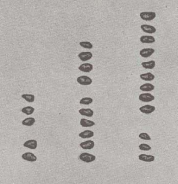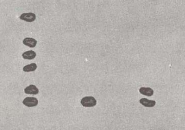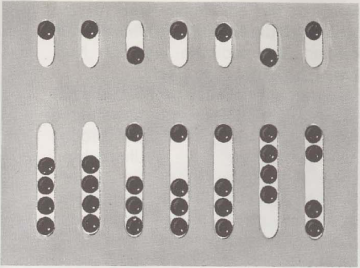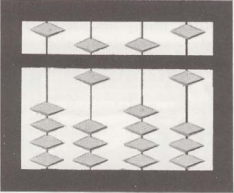Egyptians, Babylonians and Greeks used the abacus even before the Romans. The Chinese and Japanese were also familiar with such simple counting machines. The abacus is still used today in China and Japan, and the few, who still use it, are so good with it, that they can solve problems almost as quickly as an electric calculator. The abacus has come in many forms and under different names, is after, when and where it was needed, but the procedure was always the same in principle. It has single rows of glass beads, plates or balls, and these series are arranged according to the place value system, that the Sumerians invented. The earliest and simplest abacus was a counting board, used by the Babylonian merchants.
One 263 and 349 to add, we put stones on the board like this, that she 263 mean: 2 hundreds, 6 tens and 3 one. We then add stones,

 the 349 specify: 3 hundreds, 4 tens and 9 one.
the 349 specify: 3 hundreds, 4 tens and 9 one.
Since no row more than 9 can have stones (10 one = 1 tens), let's take first 9 Stones from the one row (right) away, then we take the tenth and put it in the row of ten. There are now two stones left in the one-row.

But in the tens (middle row) are also more than 9 stones. One takes again here 9 Stones away and put the tenth in the hundred row (links). Now the stones give the answer: 612.

The Roman counting board, the abacus, was metal, and in each row were small balls. To denote a number, the balls were pushed towards the middle. The balls above were worth 5, the lower of 1. The first row on the right is the one-, the second the row of ten and so on. The number shown is according to our counting system: 0061 192 = 61 192. In Asia, the abacus was called "suan-pan" by the Chinese and "soro-ban" by the Japanese. The pieces of glass on the divider rail of the frame form a number, Our illustration shows, like the number 651 is written: !n the row of hundreds is one at the top 5 and one below 1, in the

row of ten one 5 and in the one row one 1.
We want now 152 to the 651 to add. We push first 2 One piece to the dividing rail (right row). One 5 to add to the tens series, we slide all four bottom pieces of glass up. Since we, a 10 to get tens, need another piece of glass, but don't have any more in this series, let's push all tens of glass pieces away from the dividing line and in the hundreds row push a glass piece from below to the dividing line. Finally we insert in the hundred row 1 piece of glass up, and the pieces of glass give the result: 803.
